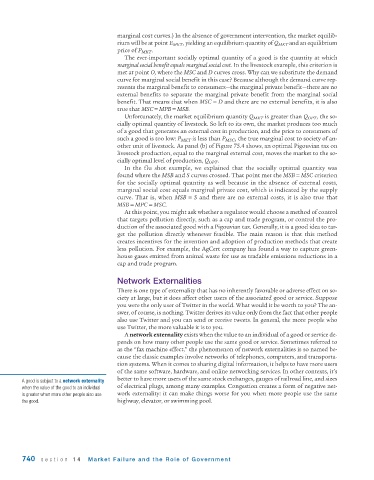Page 782 - Krugmans Economics for AP Text Book_Neat
P. 782
marginal cost curves.) In the absence of government intervention, the market equilib-
rium will be at point E MKT , yielding an equilibrium quantity of Q MKT and an equilibrium
price of P MKT .
The ever-important socially optimal quantity of a good is the quantity at which
marginal social benefit equals marginal social cost. In the livestock example, this criterion is
met at point O, where the MSC and D curves cross. Why can we substitute the demand
curve for marginal social benefit in this case? Because although the demand curve rep-
resents the marginal benefit to consumers—the marginal private benefit—there are no
external benefits to separate the marginal private benefit from the marginal social
benefit. That means that when MSC = D and there are no external benefits, it is also
true that MSC = MPB = MSB.
Unfortunately, the market equilibrium quantity Q MKT is greater than Q OPT , the so-
cially optimal quantity of livestock. So left to its own, the market produces too much
of a good that generates an external cost in production, and the price to consumers of
such a good is too low: P MKT is less than P MSC , the true marginal cost to society of an-
other unit of livestock. As panel (b) of Figure 75.4 shows, an optimal Pigouvian tax on
livestock production, equal to the marginal external cost, moves the market to the so-
cially optimal level of production, Q OPT .
In the flu shot example, we explained that the socially optimal quantity was
found where the MSB and S curves crossed. That point met the MSB = MSC criterion
for the socially optimal quantity as well because in the absence of external costs,
marginal social cost equals marginal private cost, which is indicated by the supply
curve. That is, when MSB = S and there are no external costs, it is also true that
MSB = MPC = MSC.
At this point, you might ask whether a regulator would choose a method of control
that targets pollution directly, such as a cap and trade program, or control the pro-
duction of the associated good with a Pigouvian tax. Generally, it is a good idea to tar-
get the pollution directly whenever feasible. The main reason is that this method
creates incentives for the invention and adoption of production methods that create
less pollution. For example, the AgCert company has found a way to capture green-
house gases emitted from animal waste for use as tradable emissions reductions in a
cap and trade program.
Network Externalities
There is one type of externality that has no inherently favorable or adverse effect on so-
ciety at large, but it does affect other users of the associated good or service. Suppose
you were the only user of Twitter in the world. What would it be worth to you? The an-
swer, of course, is nothing. Twitter derives its value only from the fact that other people
also use Twitter and you can send or receive tweets. In general, the more people who
use Twitter, the more valuable it is to you.
A network externality exists when the value to an individual of a good or service de-
pends on how many other people use the same good or service. Sometimes referred to
as the “fax machine effect,” the phenomenon of network externalities is so named be-
cause the classic examples involve networks of telephones, computers, and transporta-
tion systems. When it comes to sharing digital information, it helps to have more users
of the same software, hardware, and online networking services. In other contexts, it’s
better to have more users of the same stock exchanges, gauges of railroad line, and sizes
A good is subject to a network externality
when the value of the good to an individual of electrical plugs, among many examples. Congestion creates a form of negative net-
is greater when more other people also use work externality: it can make things worse for you when more people use the same
the good. highway, elevator, or swimming pool.
740 section 14 Market Failure and the Role of Gover nment

